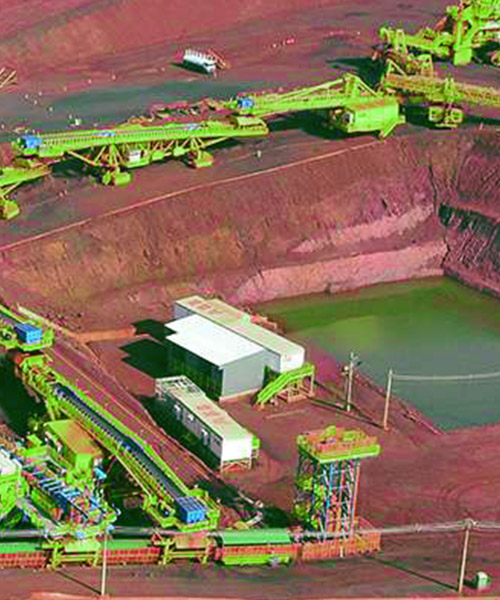July 09, 2025 • 5 mins read
Hybrid haulage: A smarter path to sustainable mining
The mining industry is increasingly exploring innovative solutions to reduce its environmental footprint. One such solution is In-Pit Crushing and Conveying (IPCC) systems, which can offer a more sustainable and efficient alternative to traditional diesel truck haulage.
However, as the sector progress on its decarbonization journey, battery-electric haul trucks (BEHT) are gaining traction as a viable alternative to diesel-powered transport. BEHT promise to reduce emissions and align with broader sustainability goals. However, questions persist regarding their scalability, operational efficiency, and cost-effectiveness – particularly in large-scale mining operations – compared to IPCC systems as the industry awaits commercially available BEHT exceeding 140 tonnes.
Both technologies present potential, but with each there are intricate trade-offs involved. The right choice depends on site-specific considerations, project objectives and a clear understanding of long-term value and operational priorities.
IPCC: a proven solution with room for improvement
“IPCC systems have been in operation for years, with several mining companies adopting them to reduce reliance on trucks and improve efficiency,” starts Nicholas Russell, Principal Mechanical Engineer. “Their key benefit lies in using conveyors for material transport, which is more energy efficient. By replacing trucks, IPCC systems significantly reduce fuel use and emissions.” At some sites, IPCC also supports mine closure by creating better landforms for waste material reducing the need for costly dozing activities during decommissioning.
A significant advantage of IPCC systems is their ability to provide continuous material transport, unlike the cyclical nature of truck haulage. “Trucks, even those powered by batteries, require time to load, haul, and unload, often creating bottlenecks and inefficiencies. Conveyors, on the other hand, ensure steady, uninterrupted material flow from the pit to the processing plant or waste dump,” explains Russell. This continuous flow improves material handling operating time.
However, IPCC comes with upfront challenges. The system requires considerable capital investment, particularly for mobile crushers, conveyors and related infrastructure making it a challenging decision for many to commit initially. “While they can deliver long-term operational savings and sustainability benefits, initial cost commitment can be a barrier for some,” says Russell.
The extent to which IPCC can be fully ‘truckless’ varies by mine site. A fully mobile IPCC system, which would eliminate trucks entirely, may not be feasible for all operations. In many cases, hybrid solutions, which combine IPCC with a smaller truck fleet, may offer the best balance between sustainability and operational flexibility. Ultimately, it’s about understanding the site and thinking beyond the typical truck and shovel model.
BEHT: a rising star in sustainable mining
BEHT represents another promising advancement in the industry’s efforts to reduce emissions. “These electric-powered trucks are seen as a direct replacement for diesel-powered haul trucks and promise a cleaner, quieter alternative with zero emissions during operation,” adds Renee Frenette, Senior Associate Technical Consultant. “As the technology matures, it’s expected to become more widely adopted across the sector.”
However, BEHT technology is still in its infancy, particularly for larger haul trucks required in most mining operations. Current models are significantly smaller than the ones required for large-scale mining operations. Original equipment manufacturers (OEMs) estimate that these will be available between 2027 and 2030. “With many mining companies having ambitious emission reduction targets for 2030, it is expected that the demand for BEHT will surpass the OEMs production capacity,” adds Frenette.
The timeline for the rollout of these trucks is influencing strategic decisions. “Some mining companies, particularly in Australia, are choosing to wait for larger BEHT to become available to advance transitioning their fleets to fully electric,” says Frenette. “But the rollout of BEHT also depends on corresponding infrastructure readiness. The need for charging infrastructure, battery life and replacement systems, and adequate power supply are significant factors that impact the scalability of BEHT, especially in remote locations.
Despite these challenges, BEHT offers a solution making it more attractive as technology advances and OEMs reach their Technology Readiness Level (TRL) targets for full-sized electric haul truck production in the coming years.
Combining IPCC and BEHT: a hybrid approach
Given the complexities of both IPCC systems and BEHT, a hybrid approach is often seen as the most practical solution for many mining sites. “A hybrid model might involve using IPCC to handle most of the material transport, while a smaller fleet of BEHT or hybrid trucks is used in areas requiring more flexibility or where IPCC is not feasible,” suggests Russell.
A hybrid approach minimizes truck dependency and associated emissions, while leveraging the continuous material flow and efficiency of the IPCC system for improved material handling.
In the short-term, combining both technologies provides operational flexibility and scalability that a fully truckless system may not be able to offer, with each technology offering different route capabilities. “For example, the upper burden in a strip mine, trucks can travel straight across the pit, whereas IPCC typically needs to go around it. Conversely for deep pits, IPCC generally take a steeper, more direct route,” says Russell.
In Morocco, a hybrid solution is currently being studied where IPCC is being considered for one material type and BEHT for the remaining operation. “This solution allows the mine to benefit from an overall reduced fleet size, lessening the risk of supply constraints before 2030,” adds Frenette.
The role of location and policy
The adoption of IPCC and BEHT technologies varies by region, with some areas embracing these innovations more quickly than others. In China, small BEHT fleets (70‑100 tonnes) are already in use alongside several IPCC installations. Australia, meanwhile, has multiple IPCC sites in operation, and many miners – both locally and globally – are conducting desktop studies to assess the feasibility of IPCC concepts.
“Countries like Saudi Arabia and other parts of the Middle East are also exploring both technologies as part of their broader efforts to expand their mining sectors and adopt more sustainable practices,” says Russell. “As environmental regulations tighten, these regions are becoming key hotspots for the adoption of both IPCC and BEHT.
Looking ahead
As the mining industry looks to the future, the decision to adopt IPCC, BEHT, or a hybrid solution largely depends on site-specific factors. One key consideration is operational complexity. IPCC systems tend to be more complex to operate and maintain than traditional truck systems. Equipment reliability, the need for skilled personnel, and the integration of various components can present significant challenges.
Flexibility is another important factor. “Truck and shovel operations offer greater adaptability to changes in mine design, orebody shape, or production rates,” says Russell.” It’s typically easier to modify truck operations than to reconfigure a fixed IPCC setup. This flexibility is crucial for mines that experience frequent changes in operational demands.”
Terrain and geology further influence IPCC feasibility. In-pit crushing may not be practical in all mining scenarios, especially in cases where the terrain is uneven, or the geology does not support effective implementation of the technology. The logistics of moving crushed material via conveyors presents its own challenges, including maintenance, potential spillage, and the risk of breakdowns, all of which can disrupt operations.
“While many of these constraints can be managed, they lead to higher costs or increased operational risks. As a result, a hybrid approach – combining both IPCC and BEHT – may become increasingly common,” concludes Frenette. “This solution offers the advantages of both systems: the sustainability and efficiency of IPCC with the flexibility provided by BEHT, allowing for a more adaptable and balanced approach to mining operations.”
With continued advancements in both technologies, the mining industry is on track to make significant strides toward decarbonization and efficiency, delivering long-term value for both industry and the environment.




